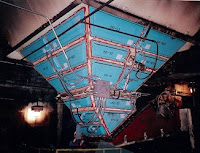 |
| Coal fired power plants must manage fly ash properly. |
Coal fired power plants in the United States require the use of electrostatic precipitators or bag houses to filter out very fine fly ash particulate incorporated in the flue gas. The ash is collected as the flue gas passes through filter bags or by large electrodes, and then falls into collection hoppers.
As the hot fly ash cools, condensate on the hopper walls can form. The mixture of dry, sulfur rich fly ash and water is very problematic, so it's very important to keep condensation from forming in the collection hoppers. The mixture of water and fly ash can cause clogging (or “pluggage”) in the throat of the hopper, and more importantly, the residual sulphur in the flue gas will combine with the condensate to form sulphuric acid. The suluric acid attacks the hopper walls from the inside causing corrosion, weakening the walls and creating significant (and costly) maintenance issues over time.
 |
| Fly ash hopper with heaters. |
Efficient and continuous fly ash removal is critical for all coal fired power plants. Collection hoppers are an integral part of the removal process. Pluggage or inoperable hoppers are a known issue to engineers and maintenance crews. The constant maintenance and excess of down time seriously hinder a plant’s ability to manage the fly ash production rate. Slower fly ash production means limiting energy production and efficiency. A power plant’s electricity production is directly proportional with its coal combustion rate which, in turn, directly effects the fly ash production rate. Plant maintenance personnel usually attempt to remedy ash system failures in real time by deactivating the affected hopper while continuing to generate power and ash. In some situations (to prevent boilers shutdowns) ash will be dumped on the floor, requiring costly clean up.
The evacuation and management of fly ash is much easier when the ash is kept hot. One of the most common ways to maintain elevated fly ash and hopper temperature are
electric hopper heaters attached to the external hopper walls. Hopper heaters play a very important role in the removal of fly ash from precipitators and bag filter hoppers by keeping the hopper temperatures operating above the flue gas acid dew point. The hopper heater’s sole function is to preheat the hopper and the internal environment to prevent the formation of moisture and the resulting clumping of fly ash and development of sulphuric acid.
 |
| Flexible heating element used on hopper throat. |
Hopper heaters are designed for the dirty, high vibration environment of a power plant. They provide the optimum watt density for proper conduction through the hopper wall and for uniform heating. The are available in square, rectangular, and trapezoidal shapes to accommodate any hopper design. Ancillary
flexible heating blankets are available for poke tubes, man-ways, and cylindrical throats.
The use of electric hopper heaters on electrostatic precipitator and bag house fly ash collection systems is a time proven, effective way to prevent condensate formation and the resulting clumping and corrosive acids in hoppers, thus facilitating a better opportunity for uninterrupted fly ash production.
For more information, contact:
Hotfoil-EHS, Inc.
2960 East State Street Ext.
Hamilton, NJ 08619
Phone # 609.588.0900
Fax # 609.588.8333
Email: dap@hotfoilehs.com
www.hotfoilehs.com











